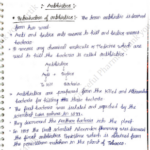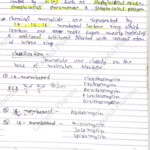QUESTION BANK
PHARMACEUTICAL INORGANIC CHEMISTRY
Subject Code: – BP-104T
Semester- I
Session-2019-20
UNIT-I (Pharmacopoeia and Limit Tests)
1. What do you mean by the term impurity? Name the types of
glasses used in pharmacy. (AKTU 2015-16)
2. Define limit test of iron in detail. ( AKTU 2015-16)
3. Write down the principle, procedure and apparatus for limit test of
Arsenic. (AKTU 2015-16)
4. Write the chemical formula of dithizone…….and it is used in the
limit test of ……….(UPTU 2014-15)
5. Enlist various sources of impurities in pharmaceutical substances
with suitable examples? Write a descriptive note on chemical
instabilities and particulate, non particulate, microbial
contaminations in pharmaceutical substances. (UPTU,2014-15)
6. The standard and test solutions used for Limit test are prepared in
………….(UPTU 2013-14)
7. Thioglycollic acid used in the Limit test of Iron as oxidizing agents
true/false(UPTU 2013-14).
8. Why dilute nitric acid used in the Limit test of Chloride ? (UPTU
2013-14).
9. Give principle, reaction and procedure involved in the Limit test of
Chloride and Sulphate. (UPTU 2013-14).
10. Nessler cylinder is used for ———– (MTU 2012-13)
11. Glasses consists of ——————(MTU 2012-13)
12. Thioglycolic acid is used in the limit test of ———-(MTU 2012-
13)
13. What are various sources of impurities in pharmaceutical
substances? Explain physical and chemical instabilities in detail.
(MTU 2012-13)
14. Write the reactions involved in the limit test of chloride.(MTU
2012-13)
15. Give the detail of limit test for sulphate (MTU, 2012-13) (MTU,
2011-12)
16. Write a detail note on sources of impurities in pharmaceuticals
(MTU,2012-13,2011-12)
17. Write in detail including diagram for limit test for Arsenic
(MTU, 2012-13,2011-12 & UPTU 2007-08)
18. Write the reaction for the limit test for lead. (MTU, 2011-12)
19. Discuss the principle and procedure for the limit test for chloride
(MTU,2011-12)
20. Write the limit test of Iron. (UPTU, 2007-08)
21. Explain with suitable examples where the storage conditions of
pharmaceutical is one of the source of impurities.
22. What do you understand by the terms purity,limit test, test for
purity and assay. What is the importance of various purity test in
pharmaceuticals?
23. Define limit test. Give the importance of the limit test in
pharmacy.
24. Give principle, procedure and reactions involved in the limit test
for lead(IP method)
25. Explain why stanned HCl is used in limit test for Arsenic.
26. Describe the limit test for Heavy metals.
27. Explain why stannated HCl acid is used in limit test for Arsenic
28. Explain the use of Silver nitrate solution in the limit test of
chloride.
29. Explain the use of Hydrochloric acid in the limit test of sulphate.
30. Discuss the limit test in which Thioglycollic acid reagents is used.
31. Explain why Thioglycollic acid solution is added to the ammonical
solution of ferrous sulphate in the limit test of Iron.
UNIT-II (Topical agents, Dental products & Antioxidants)
1. Why Povidone-Iodine is superior to iodine? ( AKTU 2015-16)
2. What are dentrifrices? Give composition of calamine. ( AKTU
2015-16)
3. Define cathartics with suitable examples. ( AKTU 2015-16)
4. What are anticaries agents? Discuss the role of fluoride. ( AKTU
2015-16)
5. Write down the preparation and uses of potassium permanganate. (
AKTU 2015-16)
6. What are antioxidants? Give the preparation and uses of Sodium
metabisulphite. ( AKTU 2015-16)
7. What are topical agents? Classify them and give the mechanism of
action of anti-infective agents. ( AKTU 2015-16)
8. Define protectives and adsorbents. Give the preparation and uses of
Aluminium Sulphate. ( AKTU 2015-16)
9. TiO2 acts as ………..(UPTU 2014-15)
10. In povidone-iodine lotion, chemically povidone is …………………(
UPTU 2014-15)
11. Pink colour of calamine is due to the presence of ……( UPTU
2014-15)
12. Give any two examples of dentrifrices. ( UPTU 2014-15)
13. Make a statement on astringents. write about the methods of
preparation and identification test of zinc sulfate. ( UPTU 2014-15)
14. Give the method of preparation and uses of any two of the
following: ( UPTU 2014-15)
a. Calamine
b. KI
c. Sodium thiosulfate
15. Give the method of preparation, identification tests and uses of
Kaolin. ( UPTU 2014-15)
16. What do you understand from anti-infective agents? Explain
various mechanisms of action of inorganic anti-microbial agents.
Give the methods of preparation and identification tests for
hydrogen peroxide. ( UPTU 2014-15)
17. What are anti-caries agents? Give method of preparation and
mechanism of action of sodium fluoride. ( UPTU 2014-15)
18. Give chemical formula for Talc.(UPTU 2013-14)
19. Give examples of Anticaries agents. (UPTU 2013-14)
20. Boric acid used as ………………… (UPTU 2013-14)
21. Explain antioxidant with suitable examples. (UPTU 2013-14)
22. Give Preparation and Reaction of: Sodium Flouride, Potassium
permanganate, Zinc sulphate, Titanium dioxide, Iodine (UPTU
2013-14)
23. What is the use of titanium dioxide ? (MTU 2012-13)
24. Potassium permangnate, used as an anti-infective agent acts
through which mechanism ? (MTU 2012-13)
25. Give any two examples of dentifrices. (MTU 2012-13)
26. Give the method of preparation identification tests and uses of
Kaolin and Boric acid. (MTU 2012-13)
27. Give identification test for Boric acid (MTU, 2012-13)
28. Give method of preparation of hydrogen peroxide solution (MTU,
2012-13)
29. Define the term astringents with example (MTU, 2012-13)
30. Give method of preparation, identification test and use of
hydrogen peroxide (MTU, 2012-13)
31. Give the detail of Light Kaolin and Talc (MTU, 2012-13)
32. Give method of preparation, identification test and use of
Povidone Iodine and Silver Nitrate (MTU, 2012-13)
33. How do astringent act? Give the identification test for zinc
sulphate. (UPTU, 2007-08)
34. Discuss the preparation and uses of boric acid (UPTU, 2007-08)
35. Write the basic principle of the assay of Boric acid with chemical
reaction.
36. What are protectives? Give example.
37. Explain in detail Calamine and Titanium dioxide
38. Why calamine is of pink color?
39. Give preparation, properties and uses of Alum.
40. What are Anti-infectives ? Give example
41. Give preparation, properties and uses of Iodine and Potassium
permanganate
42. Explain in detail about Silver nitrate.
43. Write a note on Dentrifice or anti-caries agents 18. Discuss the
preparation and uses of Sodium fluoride.
44. Write a note on Gases and vapors
45. Explain Inhalants. Write a detail note on Oxygen
46. Explain anesthetics Write a detail note on Nitrous oxide.
47. What are the colors of cylinder for carrying oxygen and nitrous
oxide?
UNIT-III (Gastrointestinal agents)
1. Explain combination antacid therapy. ( AKTU 2015-16)
2. What are antacids? Give the properties of an antacid. ( AKTU 2015-
16)
3. Ammonium chloride is used as ….( UPTU 2014-15)
4. Define hyperchlorohydria and achlorhydria? Write a note on
antacid therapy. ( UPTU 2014-15)
5. Write a note on combination therapy. ( UPTU 2014-15)
6. Give the method of preparation, identification tests and uses of
MgCO3, CaCl2 and NaHCO3. ( UPTU 2014-15)
7. What are the major physiological ions? Describe metabolic
acidosis, alkalosis and respiratory acidosis, alkalosis. Write a
comprehensive note on physiological acid base balance at the level
of tissues and kidneys. ( UPTU 2014-15)
8. Classify cathartics and write an explanatory note on saline
cathartics taking example of phosphate. ( UPTU 2014-15)
9. An ……………………… is any substance, generally a base, which
counteracts stomach acidity. ( UPTU 2013-14)
10. ………………………….. is the condition of the absence of
hydrochloric acid in the gastric secretion( UPTU 2013-14).
11. Give molecular formula for Epsum salt. ( UPTU 2013-14).
12. Give example of Bulk Forming Laxatives. ( UPTU 2013-14).
13. Which compound used as Antidiarrheal agents ? (UPTU 2013-14).
14. Classify antacids with suitable examples. (UPTU 2013-14).
15. Define Expectorants. Give preparation and reactions of
Ammonium chloride. (UPTU 2013-14).
16. Give Preparation and Reaction of: Milk of Magnesia, (UPTU 2013-
14)
17. Write the name of two important physiological buffers. (MTU
2012-13)
18. What is the main side effect of magnesium containing antacid ?
(MTU 2012-13)
19. Classify cathartics and write a descriptive note on saline cathartics
taking example of phosphates. (MTU 2012-13)
20. Give method of preparation, identification test and use of
Aluminium sulphate (MTU, 2012-13)
21. Define the term antacids. Give method of preparation,
identification test and use of any two antacids. (MTU, 2012-13)
22. Give the detail of Ferrous sulphate. (MTU, 2012-13)
23. What is an expectorant. Give two example. (MTU, 2011-12)
24. Distinguish between light and heavy Magnesium oxide. (MTU,
2011-12)
25. Write note on the following: magnesium sulphate and magnesium
carbonate. (MTU, 2011-12)
26. What are antacids? Classify them. Discuss Aluminium hydroxide
and magnesium hydroxide. (MTU, 2011-12)
27. Classify cathartics and explain how they act. Discuss the
magnesium compounds used as cathartics. (UPTU 2007-08)
28. What are the requirements of an ideal cathartic? Write a note on
combination cathartics. (UPTU 2007-08)
29. What are Expectorants? Give the preparation and the uses of
Ammonium chloride.
30. What are Acidifying agents. Explain dilute hydrochloric acid










